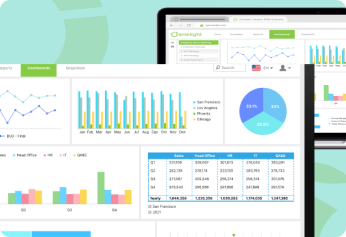Picture this: A growing SaaS company just landed their biggest client yet, but their CFO is losing sleep. Why? Because despite the good news, they can't predict whether they'll have enough cash to cover payroll next quarter. This scenario plays out in boardrooms everywhere, highlighting why cash flow forecasting isn't just helpful- it's essential for business survival.
Cash flow forecasting serves as your financial GPS, helping navigate the unpredictable terrain of business finance. This guide will walk you through everything you need to know about creating accurate forecasts that drive better decisions and ensure financial stability.
What is Cash Flow Forecasting?
Cash flow forecasting is the process of estimating how money will move in and out of your business over a specific period. Unlike profit and loss statements that show profitability, cash flow forecasts focus on actual cash availability- the lifeblood of any organization.
Definition and Purpose
At its core, cash flow forecasting predicts your future cash position by analyzing expected income and expenses. The primary purpose extends beyond simple prediction; it enables proactive financial management that prevents cash shortages and identifies investment opportunities.
A well-crafted forecast answers critical questions: Will you have enough cash to meet obligations? When should you pursue that expansion? Can you weather an unexpected expense? These insights transform reactive financial management into strategic planning.
Types of Cash Flow Forecasts
Different business needs require different forecasting approaches. Understanding each type helps you choose the right tool for your situation.
1. Short-term Forecasts (1-13 weeks)
These detailed projections focus on immediate cash needs and operational requirements. Finance teams use them for daily cash management, ensuring sufficient funds for payroll, supplier payments, and unexpected expenses.
2. Medium-term Forecasts (3-12 months)
Medium-term forecasts balance detail with strategic planning. They support budgeting processes, loan applications, and seasonal planning while providing enough granularity for operational decisions.
3. Long-term Forecasts (1-5+ years)
Strategic in nature, long-term forecasts guide major business decisions like expansion, acquisitions, or capital investments. While less precise than short-term forecasts, they reveal trends and support strategic planning.
Importance of Cash Flow Forecasting
Cash flow forecasting transforms financial management from guesswork into strategic advantage. Organizations that forecast effectively navigate challenges more smoothly and capitalize on opportunities faster.
1. Financial Stability and Planning
Financial stability requires more than profitability- it demands cash availability when needed. Forecasting reveals potential cash gaps before they become crises, allowing time to secure financing or adjust spending.
Consider a manufacturing company facing seasonal demand fluctuations. Without forecasting, they might struggle with cash shortages during slow periods or miss opportunities during peak seasons. Proper forecasting enables them to plan inventory purchases, manage working capital, and maintain steady operations year-round.
Strategic planning also benefits enormously from accurate forecasts. When you understand future cash flows, you can make informed decisions about hiring, equipment purchases, and market expansion. This foresight prevents overextension and ensures sustainable growth.
2. Risk Management
Every business faces financial risks- economic downturns, customer payment delays, unexpected expenses, or supply chain disruptions. Cash flow forecasting serves as an early warning system, identifying potential problems while solutions remain viable.
Risk mitigation becomes proactive rather than reactive. If forecasts show potential cash shortages, you can arrange credit lines, accelerate collections, or delay non-essential expenses. This preparation often means the difference between weathering storms and facing serious financial distress.
Steps to Create a Cash Flow Forecast
Creating an accurate cash flow forecast requires systematic approach and attention to detail. Follow these steps to build forecasts that drive better financial decisions.
1. Gathering Data
Accurate forecasting starts with reliable data collection. The quality of your inputs directly impacts the reliability of your outputs.
Step 1: Collect historical cash flow statements from the past 12-24 months. These reveal patterns, seasonal trends, and baseline performance metrics that inform future projections.
Step 2: Gather current sales forecasts and pipeline data. Sales teams provide insights into expected revenue timing, while customer data reveals payment patterns and collection timelines.
Step 3: Compile expense projections including fixed costs (rent, salaries, insurance) and variable expenses (materials, commissions, utilities). Don't forget periodic expenses like taxes, equipment maintenance, or annual subscriptions.
Step 4: Review accounts receivable aging reports to understand typical collection periods and identify potential payment delays.
2. Analyzing Cash Flow Drivers
Understanding what drives your cash flows enables more accurate predictions and better business decisions.
Step 1: Identify your primary revenue drivers- seasonal patterns, customer concentration, product mix, or market conditions that significantly impact cash inflows.
Step 2: Analyze expense drivers including both controllable factors (staffing levels, inventory purchases) and external influences (commodity prices, regulatory changes).
Step 3: Examine the timing differences between sales and cash receipts. B2B companies often face longer collection periods than retail businesses, affecting cash flow timing significantly.
Step 4: Consider external factors like economic conditions, industry trends, or competitive pressures that might influence future cash flows.
3. Building the Forecast Model
A well-structured model balances simplicity with accuracy, providing useful insights without overwhelming complexity.
Step 1: Choose your forecasting period and frequency. Monthly forecasts work well for most businesses, though weekly or daily forecasts may be necessary for cash-intensive operations.
Step 2: Create separate sections for cash inflows and outflows. Include categories that match your business model- sales revenue, accounts receivable collections, loan proceeds for inflows; operating expenses, capital expenditures, debt payments for outflows.
Step 3: Build in seasonality and growth assumptions based on historical data and business plans. Use percentage-based adjustments or trend analysis to project future performance.
Step 4: Include scenario planning capabilities. Create best-case, worst-case, and most-likely scenarios to understand potential outcomes and prepare appropriate responses.
4. Reviewing and Adjusting
Forecasting is an iterative process that improves with regular review and refinement.
Step 1: Compare actual results to forecasted amounts monthly. Identify significant variances and understand their causes- were assumptions incorrect, or did unexpected events occur?
Step 2: Update assumptions based on new information. Market conditions change, customer behavior evolves, and business strategies shift. Your forecast should reflect current reality.
Step 3: Refine your model based on lessons learned. If certain categories consistently vary from projections, adjust your methodology or add new variables to improve accuracy.
Step 4: Communicate results and insights to relevant stakeholders. Share not just the numbers but the story behind them- what they mean for operations, strategy, and decision-making.
Common Challenges in Cash Flow Forecasting
Even experienced finance professionals encounter obstacles when forecasting cash flows. Recognizing these challenges helps you prepare better solutions and improve forecast accuracy.
1. Data Accuracy
Garbage in, garbage out- this principle applies strongly to cash flow forecasting. Inaccurate or incomplete data undermines even the most sophisticated models.
Common data issues include outdated customer information, incorrect payment terms, or incomplete expense records. Manual data entry compounds these problems, introducing errors and consuming valuable time.
The solution involves implementing systematic data validation processes. Regular reconciliations between forecasts and actual results help identify data quality issues. Many organizations find that investing in integrated financial systems reduces manual errors and improves data reliability significantly.
2. Market Volatility
External factors beyond your control can dramatically impact cash flows. Economic downturns, supply chain disruptions, or regulatory changes can render forecasts obsolete quickly.
Building flexibility into your forecasting process helps address this challenge. Scenario planning prepares you for various outcomes, while regular forecast updates ensure you're working with current assumptions. Consider creating multiple forecast versions based on different economic scenarios.
Best Practices for Accurate Forecasts
Successful cash flow forecasting combines technical skills with practical wisdom. These best practices help improve accuracy and usefulness of your forecasts.
1. Regular Updates
Static forecasts quickly lose relevance in dynamic business environments. Regular updates keep your forecasts aligned with current reality and maintain their value for decision-making.
Monthly updates work well for most organizations, though rapidly changing businesses might need weekly or even daily updates. The key is finding a frequency that balances accuracy with resource requirements.
When updating forecasts, don't just change numbers- understand why variances occurred and what they mean for future projections. This analysis improves your forecasting skills over time and builds institutional knowledge.
2. Using Technology and Tools
Modern forecasting tools offer significant advantages over traditional spreadsheet-based approaches. They reduce manual work, improve accuracy, and provide better insights through advanced analytics.
Cloud-based FP&A platforms integrate with existing accounting systems, automatically pulling current data and reducing manual entry errors. They also offer built-in templates, scenario planning capabilities, and collaborative features that streamline the forecasting process.
When evaluating tools, consider your organization's size, complexity, and integration requirements. The best solution balances functionality with ease of use, ensuring adoption across your finance team.
3. Involving Key Stakeholders
Accurate forecasting requires input from across your organization. Sales teams understand revenue timing, operations teams know expense patterns, and executives provide strategic context.
Create a collaborative forecasting process that captures diverse perspectives while maintaining accountability. Regular forecast meetings bring stakeholders together to share insights and validate assumptions.
However, avoid "forecast by committee" where too many opinions dilute accuracy. Designate clear ownership for different forecast components while encouraging input from relevant stakeholders.
Streamline Your Cash Flow Forecasting with Modern Solutions
Cash flow forecasting doesn't have to be a time-consuming, error-prone process that keeps finance teams buried in spreadsheets. The finance teams that thrive today are those that embrace modern FP&A tools designed specifically for growing organizations.
If your team spends more time wrestling with data consolidation than analyzing insights, it might be time to explore purpose-built solutions. Limelight's FP&A platform helps finance teams move beyond spreadsheet limitations with intuitive forecasting tools, automated data integration, and pre-built templates that get you started quickly.
Ready to transform your forecasting process? Book a demo to discover how Limelight can help your team build more accurate forecasts with less manual work.
Table of Contents
Ready to put an end to outdated FP&A?
Get a perzonalized demo


